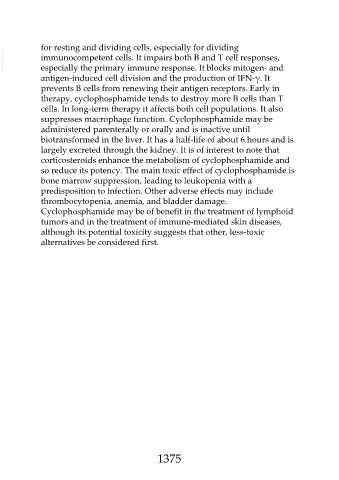Page 1375 - Veterinary Immunology, 10th Edition
P. 1375
for resting and dividing cells, especially for dividing
VetBooks.ir immunocompetent cells. It impairs both B and T cell responses,
especially the primary immune response. It blocks mitogen- and
antigen-induced cell division and the production of IFN-γ. It
prevents B cells from renewing their antigen receptors. Early in
therapy, cyclophosphamide tends to destroy more B cells than T
cells. In long-term therapy it affects both cell populations. It also
suppresses macrophage function. Cyclophosphamide may be
administered parenterally or orally and is inactive until
biotransformed in the liver. It has a half-life of about 6 hours and is
largely excreted through the kidney. It is of interest to note that
corticosteroids enhance the metabolism of cyclophosphamide and
so reduce its potency. The main toxic effect of cyclophosphamide is
bone marrow suppression, leading to leukopenia with a
predisposition to infection. Other adverse effects may include
thrombocytopenia, anemia, and bladder damage.
Cyclophosphamide may be of benefit in the treatment of lymphoid
tumors and in the treatment of immune-mediated skin diseases,
although its potential toxicity suggests that other, less-toxic
alternatives be considered first.
1375

